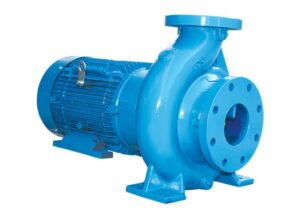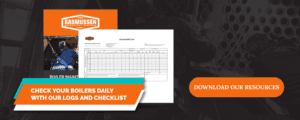Boiler feed pumps provide the boiler with the appropriate amount of water needed to maintain safe operation. The water being pumped into the system may be feedwater, condensate returns or a combination of the two depending on the system. Boiler feed pumps are generally multistage pumps. These pumps must generate enough pressure to overcome the steam pressure generated by the boiler. To do this, they use multiple impellers with bearings on the end of each shaft to overcome boiler pressure.
Horizontal Pumps
These pumps tend to be easier to install and maintain than their vertical counterparts. This is largely due to the fact that their internal parts are easier to access. While this a major benefit, the horizontal positioning also takes up more floor space in a boiler room. These pumps can typically handle up to 1500 PSIG, which is slightly lower than vertical pumps.
Vertical Pumps
These pumps take up less floor space but require more vertical space. As mentioned above these can handle higher pressures (and temperatures) than the horizontal pumps. Due to there design, these pumps also are much harder to maintain.
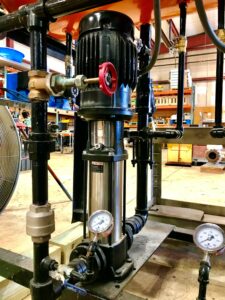

Vertical Multi-Stage Boiler Feed Pump
On/Off vs Modulating Continuous Feed Pumps
On/Off pumps rely on the low water cutoff float to activate the pump. As the float drops, an electrical signal goes to the pump, which signals it to kick on. This relatively simple setup makes these systems cheaper than modulating systems and also easier to install. Due to the on and off nature of these pumps’ differential in temperature between feedwater and the boiler can be a problem. As water is pumped in all at once it can lead to thermal shock causing issues with the metal in the surrounding area. Additionally, starting and stopping can lead to excess wear and tear on the pump and creates a fluctuating water level.
Modulating continuous pumps use more complex controls to move the feedwater valve towards open or closed based on the steam rate. These pumps are able to create steadier water levels and don’t run as big of a risk of causing thermal shock. These pumps also eliminate the excess wear and tear from continually turning off and on. Modulating continuous pumps however cost significantly more to install. This is due to the additional controls, piping, valves and an increased motor size.
Like this article? Check out our recommendations for Centrifugal Pump Maintenance here.
Feedwater And Pumps
Feed pumps are designed to handle the high temperature requirements of the boiler systems. Water turns to steam at 212 degrees Fahrenheit at atmospheric pressure. However, by pressurizing the deaerator, water will stay in its liquid form at higher temperatures. This means some pumps are designed to handle temperatures from 225 to 350 degrees Fahrenheit.
Pumps are commonly stainless steel or ductile iron. Depending on the chemical additives in the water, you may want to choose one over the other. If the wrong material is in use, it can cause corrosion on pump components over time.
Pressure Requirements
Use the list below from an article written by Industrial Steam of pressure drops to consider when calculating discharge head for a pump:
“The Total Pump Discharge Pressure must overcome the following:
System Pressure – The pressure required by the steam distribution system.
Non-Return Valve Loss – how much drop occurs across the non-return valve? The boiler must operate at a pressure high enough to overcome this and satisfy the system pressure requirements.
Economizer – The pressure drop across the waterside of the economizer.
Super Heater – The pressure drop across the waterside of the super heater.
Modulating Level Control Valve – The pressure drop across the level control valve. (not required with on-off pump control)
Feed Stop & Check Loss – Drop across the feedwater stop and check valves (if used).
Piping Loss to Boiler Height to boiler water level – The drum may be substantially higher than the boiler feedwater pumps. The pumps must be able to lift the water up to the drum level.
Total Discharge Pressure –The sum of all pressure drops the feed pump must satisfy. After the total pressure drop is calculated, it must be converted to feet of discharge head in order to select the pump. The correction factor of 2.31 converts PSIG to feet of head. We correct for the density of boiling water (227 degrees F) by dividing the head by .96.
TDH = total discharge pressure (PSIG) x 2.31 .96″
Choosing The Right Pump
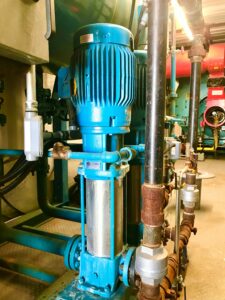
One of the main considerations when picking a pump is ensuring it can overcome the pressure in the boiler. Next you must meet specific net positive suction head requirements based on your system. This is important, because if not met your pump will cavitate. In an article written by xylem they describe cavitation as:
“Cavitation occurs when the liquid in a pump turns to a vapor at low pressure. It occurs because there is not enough pressure at the suction end of the pump, or insufficient Net Positive Suction Head available (NPSHa). When cavitation takes place, air bubbles are created at low pressure. As the liquid passes from the suction side of the impeller to the delivery side, the bubbles implode. This creates a shockwave that hits the impeller and creates pump vibration and mechanical damage. Possibly leading to complete failure of the pump at some stage.”
On top creating damage from air bubbles this can also cause vibration in the system. This vibration can lead to other mechanical issues on top of pump failure.
Next based on floor space you will want to consider whether a vertical or horizontal pump is right for your facility. Next determine the head required and the flow rate for each pump. Finally, you must decide whether a modulating continuous feed pump or an on/off feed pump is right for your facility. Ultimately choosing the right pump for your application can involve a lot of variables and should be done with help from a professional.
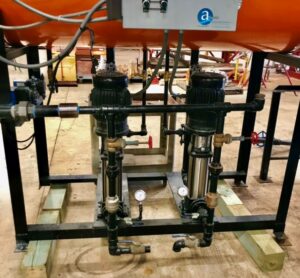
Boiler Feed Pump Redundancy
It is essential that a boiler has the water it needs to continue operating effectively. Decrease flow, and you will have a low water condition. Increase flow, and you end up with carryover. Due to this fact, most systems will have redundancy built in. As a boiler operator, it is imperative that you switch back and forth between these pumps on a regular basis. This helps ensure pumps don’t lock up from slitting idle for too long. It also will help you spot an issue before it is an emergency situation.
Boiler Feed Pump Maintenance
As a facility manager, the maintenance required on feed pumps is generally minimal. It involves occasional bearing lubrication as well as seal replacement. You will also want to occasionally check float level controls. Finally, keep an eye out for leaking piping which may be caused by corrosion occurring in the system. Contact us today for all your industrial boiler needs!


